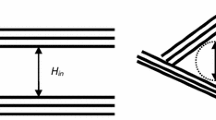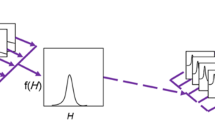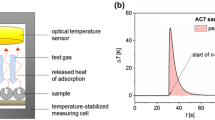Abstract
The specification of a particular activated carbon adsorbents for removal of phenol and related derivatives, from dilute aqueous solutions, is still based on lengthy trial and error experimental tests. A predictive model of adsorption of these compounds would considerably reduce the carbon selection time and could also bring new information to support more efficient carbon synthesis. The use of molecular simulation and the methodology of representative pores proved to be adequate for quantitative prediction of phenol adsorption. Here the methodology is being extended to chlorophenols, an important class of phenol-derived pollutants. A set of ortho- and para-chlorophenol isotherms were simulated for different representative pores in order to predict carbon adsorption and determine the most significative pore size. At low concentrations (1 × 10−4 mol/L), the pores of 8.9 and 18.5 Å are the most effective. For concentrations above 3 × 10−4 mol/L, pores in the range of 27.9 Å must be present in the activated carbon. The simulation predicts a step for the 27.9 Å pore that can be correlated with experimental steps in literature. Finally, the adsorption isotherms of chlorophenols for other activated carbons were predicted with the help of the model.








Similar content being viewed by others
Data availability
All relevant data are included in the paper and supplementary information. Additional data are available from the corresponding author on reasonable request.
References
Aguiar JE, de Oliveira JCA, Silvino PFG et al (2016) Correlation between PSD and adsorption of anionic dyes with different molecular weights on activated carbon. Colloids Surfaces A Physicochem Eng Asp 496:125–131. https://doi.org/10.1016/j.colsurfa.2015.09.054
Ahmaruzzaman M (2008) Adsorption of phenolic compounds on low-cost adsorbents: a review. Adv Colloid Interface Sci 143:48–67. https://doi.org/10.1016/j.cis.2008.07.002
Aktaş Ö, Çeçen F (2007) Adsorption, desorption and bioregeneration in the treatment of 2-chlorophenol with activated carbon. J Hazard Mater 141:769–777. https://doi.org/10.1016/j.jhazmat.2006.07.050
Allen MP, Tildesley DJ (1987) Computer simulation of liquids. Claredon Press Oxford, New York
Ania CO, Parra JB, Rubiera F et al (2007) A comparison of characterization methods based on Nz and CO2 adsorption for the assessment of the pore size distribution of carbons. Adsorpt J Int Adsorpt Soc 319–326
ATSDR (2021) Toxicological Profile for Chlorophenols. ATSDR’s Toxicol Profiles
Bae Y, Mulfort KL, Frost H et al (2008) Separation of CO2 from CH4 using mixed-ligand metal-organic frameworks. Langmuir 24:8592–8598. https://doi.org/10.1021/la800555x
Blanco AAG, de Oliveira JCA, López R et al (2010) A study of the pore size distribution for activated carbon monoliths and their relationship with the storage of methane and hydrogen. Colloids Surfaces A Physicochem Eng Asp 357:74–83. https://doi.org/10.1016/j.colsurfa.2010.01.006
Caturla F, Martín-Martínez JM, Molina-Sabio M et al (1988) Adsorption of substituted phenols on activated carbon. J Colloid Interface Sci 124:528–534. https://doi.org/10.1016/0021-9797(88)90189-0
Chandler, (2005) Interfaces and the driving force of hydrophobic assembly. Nature 437(2005):640–647
Chempath S, Snurr RQ, Low JJ et al (2004) Molecular modeling of binary liquid-phase adsorption of aromatics in silicalite. Langmuir 20:463–469. https://doi.org/10.1002/aic.10040
de Oliveira JCA, López RH, Toso JP et al (2011) On the influence of heterogeneity of graphene sheets in the determination of the pore size distribution of activated carbons. Adsorption. https://doi.org/10.1007/s10450-011-9343-5
de Oliveira JCA, Galdino AL, Gonçalves DV et al (2021) Representative pores: an efficient method to characterize activated carbons. Front Chem 8:1–9. https://doi.org/10.3389/fchem.2020.595230
Do DD, Do HD (2006) Effects of potential models on the adsorption of carbon dioxide on graphitized thermal carbon black: GCMC computer simulations. Colloids Surfaces A Physicochem Eng Asp 277:239–248. https://doi.org/10.1016/j.colsurfa.2005.11.094
Frenkel D, Smit B (2002) Understanding molecular simulation from algorithms to application. Academic Press, New York
Galdino AL, Oliveira JCA, Magalhaes ML, Lucena SMP (2021) Prediction of the phenol removal capacity from water by adsorption on activated carbon. Water Sci Technol 84:135–143. https://doi.org/10.2166/wst.2021.196
Garba ZN, Zhou W, Lawan I et al (2019) An overview of chlorophenols as contaminants and their removal from wastewater by adsorption: a review. J Environ Manag 241:59–75. https://doi.org/10.1016/j.jenvman.2019.04.004
Gonçalves DV, Paiva MAG, Oliveira JCA et al (2018) Prediction of the monocomponent adsorption of H2S and mixtures with CO2 and CH4 on activated carbons. Colloids Surfaces A Physicochem Eng Asp 559:342–350. https://doi.org/10.1016/j.colsurfa.2018.09.082
Gryglewicz G, Grabas K, Lorenc-Grabowska E (2002) Preparation and characterization of spherical activated carbons from oil agglomerated bituminous coals for removing organic impurities from water. Carbon N Y 40:2403–2411. https://doi.org/10.1016/S0008-6223(02)00119-7
Hadi S, Taheri E, Amin MM et al (2021) Adsorption of 4-chlorophenol by magnetized activated carbon from pomegranate husk using dual stage chemical activation. Chemosphere 270:128623. https://doi.org/10.1016/j.chemosphere.2020.128623
Häggblom MM, Bossert ID (eds) (2003) Dehalogenation microbial processes and environmental applications. Kluwer Academic Publishers, New York
Jorgensen WL, Maxwell DS, Tirado-rives J (1996) Development and testing of the OPLS all-atom force field on conformational energetics and properties of organic liquids. J Am Chem Soc 118:11225–11236. https://doi.org/10.1021/ja9621760
Kowalczyk P, Deditius A, Ela WP et al (2018) Super-sieving effect in phenol adsorption from aqueous solutions on nanoporous carbon beads. Carbon N Y 135:12–20. https://doi.org/10.1016/j.carbon.2018.03.063
Lucena SMP, Snurr RQ, Cavalcante CL (2008) Studies on adsorption equilibrium of xylenes in AEL framework using biased GCMC and energy minimization. Microporous Mesoporous Mater 111:89–96. https://doi.org/10.1016/j.micromeso.2007.07.021
Lucena SMP, Frutuoso LFA, Silvino PFG et al (2010) Molecular simulation of collection of methane isotherms in carbon material using all-atom and united atom models. Colloids Surfaces A Physicochem Eng Asp 357:53–60. https://doi.org/10.1016/j.colsurfa.2009.12.015
Lucena SMP, Gomes VA, Gonçalves DV et al (2013) Molecular simulation of the accumulation of alkanes from natural gas in carbonaceous materials. Carbon N Y 61:624–632. https://doi.org/10.1016/j.carbon.2013.05.046
Lucena SMP, Oliveira JCA, Gonçalves DV, Silvino PFG (2017) Second-generation kernel for characterization of carbonaceous material by adsorption. Carbon N Y 119:378–385. https://doi.org/10.1016/j.carbon.2017.04.061
Marsh H, Rodriguez-Reinoso F (2006) Activated carbon. Elsevier Science, London
Martins LFG, Parreira MCB, Ramalho JPP et al (2015) Prediction of diffusion coefficients of chlorophenols in water by computer simulation. Fluid Phase Equilib 396:9–19. https://doi.org/10.1016/j.fluid.2015.03.026
Nguyen TX, Cohaut N, Bae J-S, Bhatia SK (2008) New method for atomistic modeling of the microstructure of activated carbons using hybrid reverse Monte Carlo simulation. Langmuir 24:7912–7922. https://doi.org/10.1021/la800351d
Nicholson D, Parsonage NG (1982) Computer simulation and the statistical mechanics of adsorption. Academic Press, London
Olaniran AO, Igbinosa EO (2011) Chlorophenols and other related derivatives of environmental concern: properties, distribution and microbial degradation processes. Chemosphere 83:1297–1306. https://doi.org/10.1016/j.chemosphere.2011.04.009
Ravikovitch PI, Vishnyakov A, Russo R, Neimark AV (2000) Unified approach to pore size characterization of microporous carbonaceous materials from N2, Ar, and CO2 adsorption isotherms. Langmuir 16:2311–2320. https://doi.org/10.1021/la991011c
Sander R (2015) Compilation of Henry’s law constants (version 4.0) for water as solvent. Atmos Chem Phys 15:4399–4981. https://doi.org/10.5194/acp-15-4399-2015
Soares Maia DA, Alexandre de Oliveira JC, Nazzarro MS et al (2018) CO 2 gas-adsorption calorimetry applied to the study of chemically activated carbons. Chem Eng Res Des 136:753–760. https://doi.org/10.1016/j.cherd.2018.06.034
Vishnyakov A, Ravikovitch PI, Neimark AV (1999) Molecular level models for CO 2 sorption in nanopores. Langmuir 15:8736–8742. https://doi.org/10.1021/la990726c
Wang T, Liang H, Bai L et al (2020) Adsorption behavior of powdered activated carbon to control capacitive deionization fouling of organic matter. Chem Eng J 384:123277. https://doi.org/10.1016/j.cej.2019.123277
Yang Q, Zhong C (2006) Molecular simulation of carbon dioxide/methane/hydrogen mixture adsorption in metal-organic frameworks. J Phys Chem B 110:17776–17783. https://doi.org/10.1021/jp062723w
Acknowledgements
The authors would like to thank PETROBRAS, CAPES, and CNPq for the financial support and the use of the computer cluster at National Laboratory of Scientific Computing (LNCC/MCTI, Brazil).
Author information
Authors and Affiliations
Contributions
JC and SM assisted in the development and writing of the paper. JC and PR were involved in molecular simulation. SM performs the review and editing of the manuscript.
Corresponding author
Ethics declarations
Ethical approval and consent
Ethical approval is not required.
Consent for publication
The authors give consent to publish.
Competing interests
The authors declare no competing interests.
Additional information
Responsible Editor: Tito Roberto Cadaval Jr
Publisher's note
Springer Nature remains neutral with regard to jurisdictional claims in published maps and institutional affiliations.
Supplementary Information
Below is the link to the electronic supplementary material.
Rights and permissions
About this article
Cite this article
de Oliveira, J.C.A., Rodrigues, P.R.M. & de Lucena, S.M.P. Prediction of chlorophenols adsorption on activated carbons by representative pores method. Environ Sci Pollut Res 29, 79866–79874 (2022). https://doi.org/10.1007/s11356-022-18571-x
Received:
Accepted:
Published:
Issue Date:
DOI: https://doi.org/10.1007/s11356-022-18571-x




